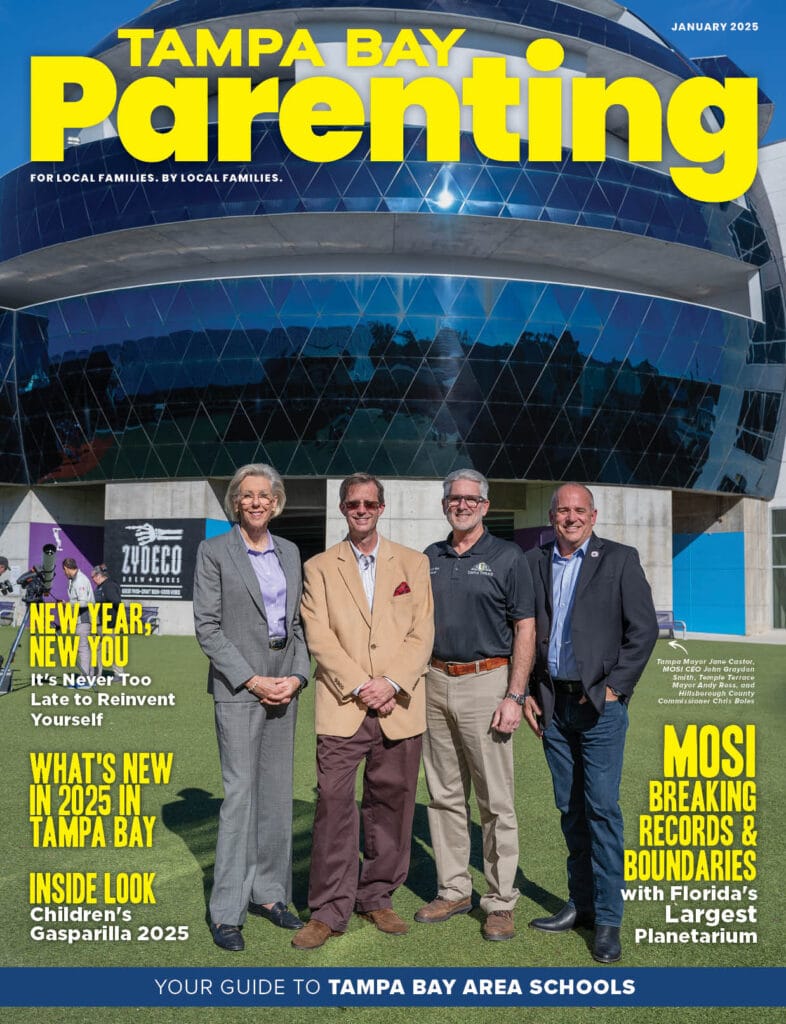Florida’s Largest Planetarium Now Open at MOSI
MOSI, Tampa’s Museum of Science & Industry, is ready to blow your mind, recently unveiling Florida’s largest digital dome theater and planetarium – the second largest in the country – inside the iconic blue dome that once housed an outdated IMAX theater.
With eyes looking up and jaws dropping down, students from Hillsborough County Public Schools became the first to experience the brand-new Digital Dome Theatre at MOSI, Tampa’s Museum of Science & Industry, during its grand opening.
At the drop of a purple ribbon, students from Tampa’s Forest Hills, Lewis and Shaw Elementary Schools took their seats inside the massive theatre, tilting their heads back to take in the towering, 10,000-square-foot screen.
Retired NASA Astronaut Nicole Stott, who grew up in Clearwater, spoke to the students about their limitless potential.
“We have, right now, future astronauts, right here in Tampa Bay,” Stott said. “And not just astronauts, but designers, engineers, nurses and artists – all waiting to discover what’s possible for them. And I’m so excited that we can do that here in this amazing space.”
It's one of several exciting new attractions opening in 2025 in Tampa Bay.
MOSI's Planetarium Immerses You In a Whole New World of Entertainment
When you step inside MOSI’s new Digital Dome Theatre, you’ll find yourself fully immersed in a 360-degree movie or soaring through space during a planetarium tour of the night sky.
“You are going to come in and forget that you are on Earth when you are in that building watching a show,” says John Graydon Smith, MOSI CEO. “This is a surround-you-with-science experience. We do that at MOSI. We are all about immersion. We are all about coming in and forgetting that you are learning.”
The new 8-story-tall screen, ten 8K digital projectors, custom speakers, and a laser light system work together to propel you into worlds you’ve only imagined exploring—whether you are flying across the solar system, journeying to the depths of our world’s oceans or even experiencing a concert in a whole new way.
“We can give you a Taylor Swift laser music show, and we will, I promise,” Smith says.
MOSI's New Digital Dome Theatre and Planetarium will be record-breaking for Florida
MOSI’s Digital Dome Theatre and Planetarium is Florida's largest and narrowly missed the number one spot nationwide, beaten by just a few feet by the planetarium at the Liberty Science Center just outside New York City.
It is seven times larger than the old Saunders Planetarium, with seating for 300+-plus people. This means kids who visit MOSI on school field trips will no longer miss out due to limited seating.
“That extra capacity in field trips not only shores up MOSI as an anchor institution, but it allows us to further our partnership with the area school districts,” Smith says.
“Hillsborough County Public Schools has already committed, thanks to the results of the new millage that passed, to sending every fourth grader from Hillsborough County through MOSI on a field trip every year. That’s thousands of kids who never have to worry about if and when they’ll ever get to have this kind of experience.”
The Goal: Inspiring Future STEM Careers
The goal isn’t just to awe and amaze but to spark curiosity and inspire future careers in the growing fields of STEM: Science, Technology, Engineering, and Math.
“We have companies moving here every day, either relocating their headquarters or expanding into the Tampa Bay region, and one of the reasons they do that—besides the fact that we’re paradise—is we have the skilled workforce available,” says Tampa Mayor Jane Castor during a recent news conference to unveil the planetarium. “MOSI plays an incredible part in continuing to develop that skilled workforce for those future jobs, many of which we couldn’t even describe today.”
“I have no doubt as we continue to support these efforts here that we will continue to grow and help this area become a hub of innovation, science, and who knows, maybe some invention too,” Hillsborough County Commissioner and MOSI Board Member Chris Boles weighed in.
Community Collaboration is Making it All Possible
Private and public funds are helping cover the multi-million-dollar price tag, and more fundraising work must be done. Naming rights are still on the table for potential supporters. It’s a chance to be a part of MOSI’s ongoing reinvention in an area that’s set to become Tampa Bay’s next big thing.
If you ask local leaders about the next area to watch for major redevelopment in Hillsborough County, they’ll tell you: Look to the 67 acres surrounding MOSI, near USF—dubbed Tampa Bay’s Uptown Innovation District.
“This has been a long time coming,” says Temple Terrace Mayor Andy Ross. “Not because there are any villains in this, but because this is a difficult area to develop. You’ve got the confluence of several large and stubborn jurisdictions here.”
While plans to redevelop this area are underway, MOSI is taking the lead.
“We have visionary leaders, we have a great community that is always rolling up their sleeves and doing what is necessary to make sure that Tampa, Temple Terrace and Hillsborough County can reach success, can reach the potential that we know we have here today,” Castor says. “It is such an exciting time in our community.”
And while this project is an investment in education, it’s also an investment in fun. Smith did promise a Taylor Swift laser light show, after all.
“It’s a fantastic asset to this community,” he said of the theater inside MOSI’s iconic blue dome, which will bring back immersive shows in the next few months after going dark since 2017. “It’s on the Tampa Monopoly board – people should be allowed to go in there, right?”
Learn more about events and activities at MOSI by visiting mosi.org.
Pictured below on our January 2025 cover:
Tampa Mayor Jane Castor, MOSI CEO John Graydon Smith, Temple Terrace Mayor Andy Ross, and Hillsborough County Commissioner Chris Boles.



